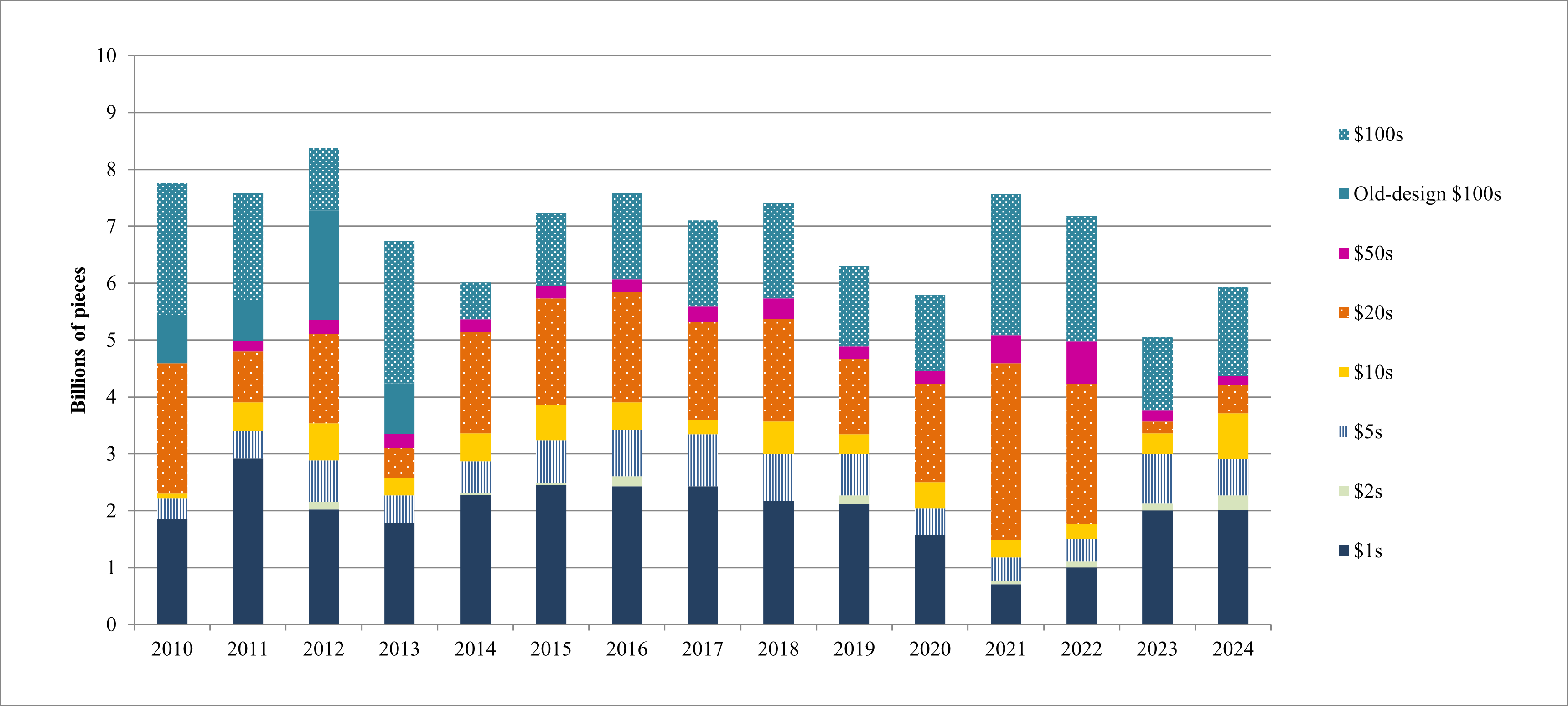2024 Federal Reserve Note Print Order
The Board of Governors, as the issuing authority for Federal Reserve notes, approved and submitted its calendar year (CY) 2024 print order to the U.S. Department of Treasury, Bureau of Engraving and Printing (BEP), on July 17, 2023.1 The CY 2024 print order contains a range of 5.3 billion to 6.9 billion notes, valued at $180.5 billion to $204.4 billion. During CY 2024, Board and BEP staff will adjust production of each denomination within this range to best match available production with demand throughout the year.
The print order reflects the Board’s estimate of net demand for currency from domestic and international customers for CY 2024. It is determined by several factors, including forecasted currency inventory volumes, destruction rates of unfit notes, and trends in net payments. This year’s print order follows pre-pandemic trends in which the primary driver of the order was the need to replace unfit notes destroyed during normal processing.2
In addition, the CY 2024 print order demonstrates a commitment shared between the Board and BEP to allocate BEP’s production capacity to essential projects supporting the U.S. Currency Program’s strategic priorities. These priorities include producing the new banknote series with the signatures of the Secretary and Treasurer, banknote production process improvement testing, validating new equipment, and transitioning addition denominations to 50-subject based sheets to improve efficiency and quality. The Board and BEP agree on the need to allocate resources to achieve the planned security feature and banknote design milestones required to meet the Department of Treasury’s announced 2026 issuance date for the Catalyst $10, which will require production of that note to start in 2025.
The table below reflects the denominational breakdown of the CY 2024 print order and the range of notes planned for each denomination.
| Denomination | Print Order (000s of pieces) | Dollar value (000s) |
|---|---|---|
| $1 | 1,785,600 to 2,265,600 | $1,785,600 to $2,265,600 |
| $2 | 211,200 to 256,000 | $422,400 to $512,000 |
| $5 | 576,000 to 748,800 | $2,880,000 to $3,744,000 |
| $10 | 761,600 to 1,017,600 | $7,616,000 to $10,176,000 |
| $20 | 352,000 to 825,600 | $7,040,000 to $16,512,000 |
| $50 | 99,200 to 211,200 | $4,960,000 to $10,560,000 |
| $100 | 1,558,400 to 1,606,400 | $155,840,000 to $160,640,000 |
| Total | 5,344,000 to 6,931,200 | $180,544,000 to $204,409,600 |
The CY 2024 print order ranges from 5.3 billion to 6.9 billion notes. The lower range of the order is an increase of about 0.8 billion notes, or 17.4 percent, from the lower range of the revised FY 2023 print order. The upper range of the order is a decrease of about 1.7 billion notes, or 20.0 percent, from the upper range of the revised FY 2023 print order.
Currency in circulation, a direct measure of demand for Federal Reserve notes, increased by 0.8 billion notes or $58.5 billion dollars between July 2022 and July 2023. During the same period the previous year, currency in circulation increased by 0.8 billion notes, or $86.8 billion dollars. Year over year, currency in circulation continues to increase though the rate at which it is increasing has fallen below pre-pandemic levels.
Appendix
Chart 1
Historical FY Print Orders
Note: Starting in FY 2021, the print order was submitted as a range by denomination. The bars for FY 2021 and onward represent the number of banknotes the BEP committed to deliver in its respective fiscal year. Starting in 2024, the print order was submitted on a calendar-year basis. The bars for CY 2024 and onward represent a calendar year print order.
Footnotes
1. This is the first year the Board will issue a print order in July for the subsequent calendar year, shifting from a fiscal year print order. This change was driven by the benefits of an increased supply chain lead time and longer production planning horizons for the BEP. Return to text.
2. Unfit notes are notes that are received in deposits from depository institutions that are destroyed because they do not meet the Federal Reserve's quality criteria for recirculation. Return to text.
